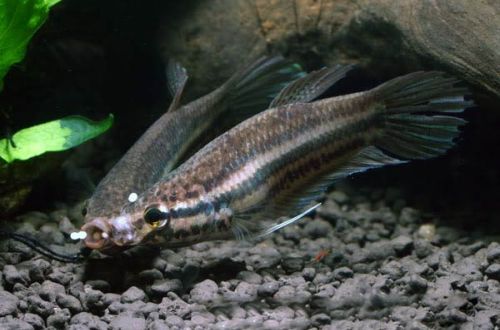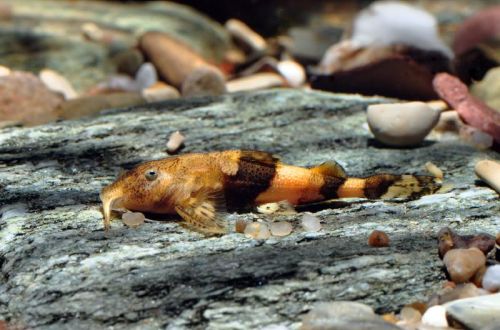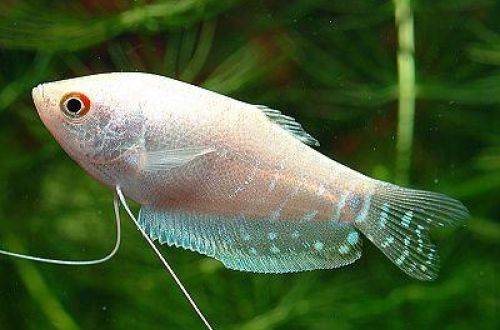
Cockerel Prima
Cockerel Prima or Betta Prima, scientific name Betta prima, belongs to the Osphronemidae family. A peaceful calm fish that gets along well with other species of comparable size. Relatively easy to keep and breed. The only downside is the dull coloring.

Contents
Habitat
It comes from Southeast Asia, the natural habitat covers the vast expanses of the Mekong River basin in the territory of modern Cambodia, Vietnam, southeast Thailand, Laos. Inhabits forest swamps and streams connected with them, does not occur in the main channels of rivers. A typical biotope is a low-flowing reservoir with substrates of stones, boulders mixed with plant material (leaves, twigs, driftwood, etc.). The dense crowns of trees do not let in much light, so aquatic plants are mainly represented by mosses and ferns. The water has a dark brown color due to the high concentration of humic acids and other substances released as a result of the decomposition of organic matter.
Brief information:
- The volume of the aquarium – from 50 liters.
- Temperature – 23-27°C
- Value pH — 4.0–7.0
- Water hardness – 1–10 dGH
- Substrate type – any dark
- Lighting – subdued
- Brackish water – no
- Water movement – little or no
- The size of the fish is 4–5 cm.
- Food – any food
- Temperament – peaceful
- Content – alone, in pairs or in a group together with other species
Description
Adults reach a length of 4–5 cm. Males, unlike females, grow larger and have a wider head shape. The coloration is gray with a barely noticeable turquoise tint, concentrated for the most part on the fins and tail. Females additionally have a pattern of horizontal dark stripes stretching from head to tail.
Food
In the wild, they feed on insects and other small invertebrates/zooplankton. Acclimatized fish have successfully adapted to accepting alternative foods. The daily diet may consist of dry, frozen and live foods popular in the aquarium trade.
Maintenance and care, arrangement of the aquarium
The optimal size of an aquarium for a single couple or a small group starts from 50 liters. The choice of design is not of great importance and is selected at the discretion of the aquarist or based on the needs of other fish. However, it is desirable to provide for several important points – this is a subdued level of lighting and the availability of places for shelters. For example, shading can be done with the help of floating plants, and driftwood and other decorative elements of decor will serve as safe havens.
Successful long-term management of Petushka Prima depends entirely on maintaining a stable aquatic environment within an acceptable range of temperatures and hydrochemical values. High water quality is ensured by regular aquarium maintenance procedures (replacing part of the water, removing waste) and the smooth operation of equipment, in particular the filtration system.
Behavior and Compatibility
They belong to the group of fighting fish, which implies certain behavioral features, but not in this case. Betta Prima is characterized by a calm disposition in relation to other species and between relatives. Although there is competition between females for position in the intraspecific hierarchy, this rivalry is usually of a peaceful display nature. Compatible with non-aggressive fish of comparable size.
Breeding / breeding
Breeding is not very difficult if the fish are kept in suitable conditions for them and receive balanced feed. With the onset of the breeding season, the male and female form a pair. After a long courtship, the moment of spawning comes, accompanied by a kind of “dance of hugs”, during which the fish are closely pressed against each other, as if wrapped around their bodies.
Unlike many other species, they are caring parents. Bettra developed an unusual strategy to protect their offspring. They do not lay eggs on the ground or among plants. At the time of spawning, the male takes the fertilized eggs into his mouth, where they will stay until the fry appear – 7-12 days. Juveniles can be near their parents, it is noted that in this case they grow faster. Feed with specialized products for aquarium fish fry, or, if available, with infusoria shoes, and later with brine shrimp nauplii.
Fish diseases
The cause of most diseases is unsuitable conditions of detention. A stable habitat will be the key to successful keeping. In the event of symptoms of the disease, first of all, the quality of the water should be checked and, if deviations are found, measures should be taken to correct the situation. If symptoms persist or even worsen, medical treatment will be required. Read more about symptoms and treatments in the Aquarium Fish Diseases section.





